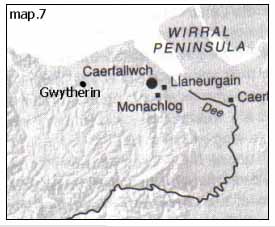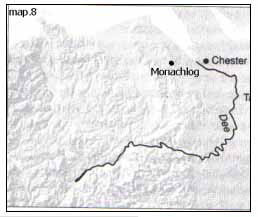Chester: A Virtual Stroll Around the Walls
Melkin's Prophecy VII
by Steve Goodwin
On to Chapters 8 | 9 | 10 | Bibliography | Back to Chapters 1 | 2 | 3 | 4 | 5 | 6
 he prophecy continues: “Among these Joseph of Arimathea hath found perpetual sleep in a marble tomb”.
he prophecy continues: “Among these Joseph of Arimathea hath found perpetual sleep in a marble tomb”.
Here again the prophecy implies that within the pagan burial ground was the grave of Joseph of Arimathea, and that he was the first ‘Christian’ to be buried there. So therefore, the inference is that this is the pivotal point suggested earlier in the prophecy, it points to Afallach’s ‘Pagan’ past and its ‘Christian’ future.
Before we look at the biblical Joseph and his subsequent burial site we shall first examine what Joseph was buried in. The prophecy claims that Joseph was buried in a marble tomb or sarcophagus. As marble is scarce in Britain it may have been imported by way of one of the famous western trade routes, the same routes which handled the export of local minerals (lead, copper, silver) from Meols, on the Wirral. Archaeological finds from Meols suggest that this was an important port for the region. Numerous finds including coins from North Africa, Gaul and Celtic Britain, suggest the site was in continuous use before and after the Roman period of occupation. An indication of Meols’ international reach is a 6th century pottery pilgrim’s flask from the shrine of St. Mennas in Alexandria, Egypt. The flask points to the possible religious connection between western Britain and the eastern Mediterranean. This is also echoed in Procopious’ account when he states that the Byzantine Emperor was attempting to re-unify the western empire by sending envoys to gages support for this amongst the British elite. The importance of the site is indicated by research that states: “It has been suggested that the exotic finds from  Meols represent trading connexions with the Mediterranean by way of the western seaways during the Iron Age. The principal object of the trade may have been the mineral wealth of north Wales, certainly exploited during the Roman period, with Meols operated as an entrepot.” (Victoria History:1987 p.104)
Meols represent trading connexions with the Mediterranean by way of the western seaways during the Iron Age. The principal object of the trade may have been the mineral wealth of north Wales, certainly exploited during the Roman period, with Meols operated as an entrepot.” (Victoria History:1987 p.104)
Furthermore, some of the pottery bowls found at Meols are identical to those found in the late-Roman hoard at Halkyn and the stone inscription to Emperor Justinian (mid 6th century) discovered at Penmachno, North Wales. These connections will be developed further later in this paper.
Interestingly, this same mineral rich Halkyn Mountain, on which we find Afallach, also yields a rare hard stone full of fossils that, when ground and polished, is called “Halkyn Marble” after the mountain from which it is hewn.
In many early documents Joseph of Arimathea is described as a “noble decurio”. According to Gardner (1996) a decurio was an overseer of a mining estate, he argues that “the term originated in Spain, where Jewish metalworkers had been operative in the celebrated foundries of Toledo since the 6th century BC.” (Gardner; 1996; p.115) If this was correct it would go someway in explaining why tradition claims that Joseph was given a grant of land by a local British nobleman. Moreover, there is good evidence that there were independent mining speculators working on Halkyn Mountain extracting lead and silver for export before the Romans took control of the area. This is supported by the fact that lead ingots have been found on Halkyn Mountain, dated to 60 AD, carrying the inscription C Nipi Ascani, presumably the name of the speculator. Now, I think that this is a very important factor, as the name on the lead ingot is the same as the mining operation found just outside Glastonbury where identical ingots were excavated. So we have a real connection between Glastonbury and Afallach, a connection that would go someway in explaining the relationship between the two locations which centuries later evolved into the Glastonbury = Avalon myth.
The same people who mined for lead and silver at Glastonbury also ran the mining operation around Afallach, North Wales.
 At this point I would like to present a brief outline of John of Glastonbury’s account of Joseph coming to Britain:
At this point I would like to present a brief outline of John of Glastonbury’s account of Joseph coming to Britain:
Following the crucifixion and entombment of Jesus, Joseph of Arimathea was imprisoned by the Jewish authorities. After his release, tradition states that Joseph and his companions travelled to Western Europe and then on to Britain which was not fully under Roman control. The story goes that they made landfall on Easter morning at a place called “Wearyal” [Wirral], but were later captured by “the faithless King of Nortwallie” [North Wales]. He was eventually released by a rival king who granted Joseph a place called Wydrin (Gwytherin) which was in the realm of Avalon (Afallach). Where Joseph built a wattle church and where he was later buried.
Each place-name within this tradition can still be found in the region of N.E Wales (see map.7). Furthermore, it was Afallach where the monastery of “Perpetual Harmony” was located, where Joseph built his ‘wattle church’ and “found perpetual sleep”. So where was the Monastery of Afallach? On the lower slopes below Caer Afallach is a site called ‘Monachlog’ which is Welsh for monastery. (map.8)
To recap:
The prophecy continues: “And he lies on a forked line next to the southern corner of an oratory”
This line has vexed commentators for many centuries as the Latin text states that Joseph is buried on a “linea bifurcata”. Suggestions for this have ranged from; that he was buried in a ‘linen shirt’ or that he is buried under a cross. However, its true meaning appears to be that Joseph was buried on a line that divides, as bifurcata equates to the modern English word bifurcate which means to divide into two parts. So where is the bifurcated line?
 Edward Llwyd in 1679 wrote of a place called Mynachlog and he states “Mae Plasdy Teg A Elwir Y Vynachlog”. This translates as “There is a beautiful Hall at Mynachlog”. (Quoted in “The Pride of Northop”1999?) 150 years later Thomas Edwards (1832) in “The History of Northop” describes the site in more detail. He states that: “Within half a mile south of Pen Y Capel, is a farm-house called Monachlog, or Monastery; some years ago, part of the edifice was discernible; the walls were above a yard thick and apparently very old…Human bones have been found in a plot of land behind the house called Yr Ardd ddu…Medicinal herbs, in great variety and abundance, are found near the house; and coins have been discovered in ploughing the adjacent fields.” (T. Edwards; 1832; p.19-20).
Edward Llwyd in 1679 wrote of a place called Mynachlog and he states “Mae Plasdy Teg A Elwir Y Vynachlog”. This translates as “There is a beautiful Hall at Mynachlog”. (Quoted in “The Pride of Northop”1999?) 150 years later Thomas Edwards (1832) in “The History of Northop” describes the site in more detail. He states that: “Within half a mile south of Pen Y Capel, is a farm-house called Monachlog, or Monastery; some years ago, part of the edifice was discernible; the walls were above a yard thick and apparently very old…Human bones have been found in a plot of land behind the house called Yr Ardd ddu…Medicinal herbs, in great variety and abundance, are found near the house; and coins have been discovered in ploughing the adjacent fields.” (T. Edwards; 1832; p.19-20).
The site of Monachlog is currently a farmhouse with fine outbuildings. However, its monastic past is without question. Behind the farmhouse is the spot which Edwards calls “Yr Ardd ddu”, this translates as “The Black Garden” this is a title usually used to denote a very old burial site. As well as the numerous finds that point to the sites antiquity the site is also bisected by the linear earthwork which is known as Wats Dyke.
As I have argued earlier Wats Dyke is currently thought to date from the mid 8th century and is thought to have been contrusted by a Mercian King. The dating of this linear earthwork has been questioned by many historians. Some believe it was constructed by the Mercian’s, others argue that that it was a late-Roman construction designed to hold off the Irish and there are others who believe it has an even earlier origin. It has been dated to the Mercian era due to the fact that it lies beside another much longer earthwork called Offa’s Dyke that also is difficult to date. The dating of these dykes as Mercian comes down to us from an account attributed to a 9th century monk called Asser who states that the dykes had a Mercian origin. This is the only early reference that links the two together, and from this one line the Mercian myth has been propagated so that it appears in ever modern History books as if gospel. However: “Despite so much archaeological study and the historical evidence, Offa’s Dyke is not well-dated as an archaeological feature. As Steven Bassett has pointed out, simply because Asser assigned the dyke to Offa not mean Offa had it built.”On to part VIII
Site Front Door | Site Index | Chester:
A Virtual Stroll Around the Walls
The Black & White Picture Place | Readers Letters | Links